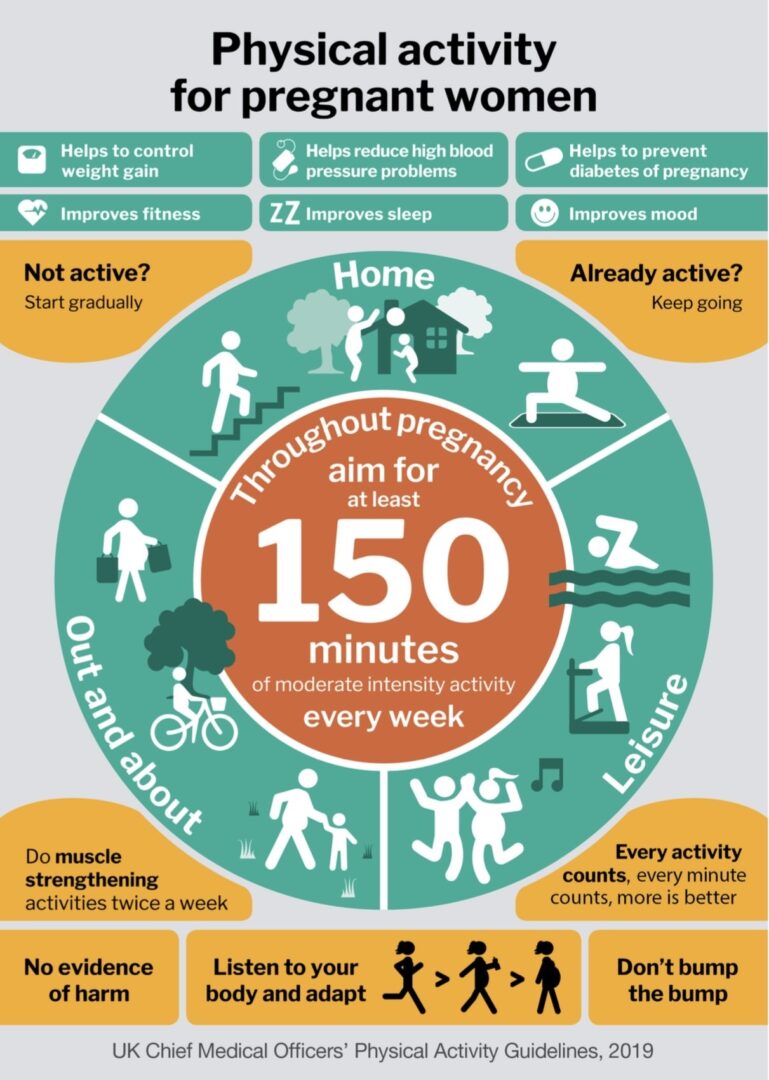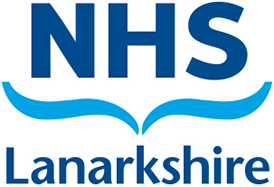Pregnancy Advice
Stay Active – Advice on Activity and Exercise
Unless you have been advised to avoid exercise during your pregnancy you can follow all of the advice below.
If you are healthy and have a low risk and uncomplicated pregnancy, we would encourage you to stay active throughout your pregnancy and try to aim for at least 150 minutes of moderate intensity activity every week. You should try to be active every day.
There is a lot of evidence to show that exercise during your pregnancy is good for you and your baby.
Exercise in pregnancy can help to prevent:
- Low back pain
- Pregnancy related pelvic girdle pain
- Depression and anxiety
- Urinary incontinence
- Putting on weight during your pregnancy
- Insulin dependent gestational diabetes
- High blood pressure problems
- Going into early labour
The benefits of exercising in pregnancy include:
- Improving your sleep
- Helping to control muscle cramps and swelling in your legs and feet.
- Being linked with shorter first stage of labour
- Reducing the risk of needing a caesarean section
- Helping your baby to maintain good weight gain
There is no evidence of any harm being caused by regular moderate intensity exercise.

UK Chief Medical Officers’ Physical Activity Guidelines, GOV.UK, © Crown copyright 2019, licensed under the Open Government Licence.
The infographic summarises the UK Chief Medical Officers’ physical activity guidelines, 2019.
Moderate intensity exercise means that you should still be able to talk, but not sing, while you are exercising.
Examples of moderate intensity physical activity include:
- yoga
- swimming
- gym activities, such as using the treadmill and resistance training with weights
- cycling
- dancing
- going for a walk
- running
It is outlined in the guidelines that you should do muscle strength training twice per week and every activity counts, every minute counts, more is better.
This video is based on the UK Chief Medical Officers’ Guidelines for Pregnant Woman
You can also find more information on specific exercises at the Active Pregnancy Foundation.
There are also free videos available from The Active Pregnancy Foundation with exercises aimed at pregnancy.
Gym Ball exercises
Gym ball exercises can help improve symptoms of Pelvic Girdle Pain. These exercises are proven to reduce stiffness in the joints around your pelvis and are a safe, gentle way of exercising
throughout your pregnancy. Please ensure to buy a gym ball which is an anti-burst type and is the right size for your height and weight.
- height of 5ft to 5ft 2inches (around 160cm) – use a 55cm gym ball
- height of 5ft 2inch – 5ft 6inch (between 160cm and 170cm) – use a 65cm gym ball
- height of 5ft 6inch – 6ft (between 160cm and 180cm) – use a 75cm gym ball
See a Gym ball exercises video below
If you are having a high risk pregnancy, or are not keeping well please speak to your obstetric team before exercising. We recommend if struggling with symptoms of PPGP you consider doing some:
- pregnancy yoga or Pilates
- swimming
Both these type of exercises are low impact, calming and great for reducing sensitivity in your nervous system. This is the best way to reduce pain.
Common Conditions In Pregnancy
During your pregnancy, your body will go through many changes. This can sometimes cause aches in your muscles and joints which you have not felt before.
Carpal Tunnel Syndrome
Carpal tunnel syndrome is caused by a build-up of fluid in the hands and wrists that presses onto the nerves.
You may feel some of these symptoms in your fingers, thumb, hand, wrist and even into your forearm:
- pain
- burning
- numbness or tingling
- shooting pains in your wrist which can go up into your forearm and elbow.
- loss of strength when gripping objects
If you feel that wrist splints would be of help to you, you can refer yourself to physiotherapy by completing this form.
Varicose Veins
- This happens when the veins swell and enlarge causing them to look blue/dark purple and lumpy.
- Most women find that their varicose veins improve after their baby is born.
For advice on how to help with these symptoms please see the Pelvic Obstetric and Gynaecological Physiotherapy’s booklets on their website.
Constipation
If you have difficulty emptying your bowels it can increase the pressure onto your pelvic floor muscles.
- Try to drink 1.5 – 2 litres of fluid per day
- Try to avoid constipation by eating a healthy diet with high fibre foods such as porridge, wholemeal bread, vegetables, beans, seeds and nuts.
You will find more advice on the British Dietetics Association food fact sheet on fibre.
Leg Cramps
These can be caused by changing pressure within your tummy and can be worse when you lie down.
It can be helpful to try some gentle exercises and stretches before going to bed:
- Circle your ankles 20 times on each leg
- Point your toes away and then pull them back up towards you so that you can feel a stretch in your calf muscles, do this 20 times.
Rib Pain
You can sometimes feel pain or discomfort around your lower ribs because of your growing baby pushing onto your ribs.
- Sitting on a gym ball can help to keep a good posture.
- Try lifting your arm above your head and reaching over to the opposite side to ease some of the discomfort.
Pelvic Floor Muscle Exercises
As your baby gets bigger there is more pressure on your pelvic floor muscles and you may notice some urine leaking from your bladder. It is very important to exercise your pelvic floor muscles regularly to keep them strong and reduce the risk of any leakages.
Watch the video below for more advice on how to do pelvic floor muscle exercises correctly.
This video was produced by NHS Highland in conjunction with Association for Continence Advice
- You will also find more advice in the Pelvic Obstetric and Gynaecological Physiotherapy’s booklets available on their website.
- Your pelvic floor exercises are for life and can help to stop you from having bladder, bowel or prolapse symptoms in the future.
- You can download the Squeezy: NHS Pelvic Floor app to help to remind and guide you through these exercises
- If you are having difficulty with your exercises or if you have any pelvic floor issues for example leaking from your bladder or bowels, or a heaviness or dragging feeling in your vagina please speak with your midwife, GP or local Pelvic Health Physiotherapist.
Relaxation
Relaxation techniques can be used at any time during your pregnancy and can help you to reduce muscle tension and to rest well.
- You can use the techniques during your pregnancy, labour and after delivery.
- Relaxation is best done lying on your side if you are more than 19 weeks pregnant.
You can also listen to how to do this relaxation technique here.

